Management Accounting Report: Financial Performance of Shell
VerifiedAdded on 2023/01/13
|12
|3345
|48
Report
AI Summary
This report delves into the application of management accounting principles within the context of Shell, a food sector organization. It begins with an introduction to management accounting, its role, principles, and functions, differentiating it from financial accounting. The report then explores various management accounting systems relevant to Shell, including inventory management, price optimization, and cost accounting systems, detailing their essential requirements and methodologies. Task 2 focuses on preparing income statements using marginal and absorption costing techniques, providing a comparative analysis. Task 3 examines the advantages and disadvantages of planning tools such as operating budgets, zero-based budgets, and cash budgets. Finally, Task 4 discusses how organizations adapt management accounting systems to address financial problems. The report concludes with a synthesis of the findings and relevant references.
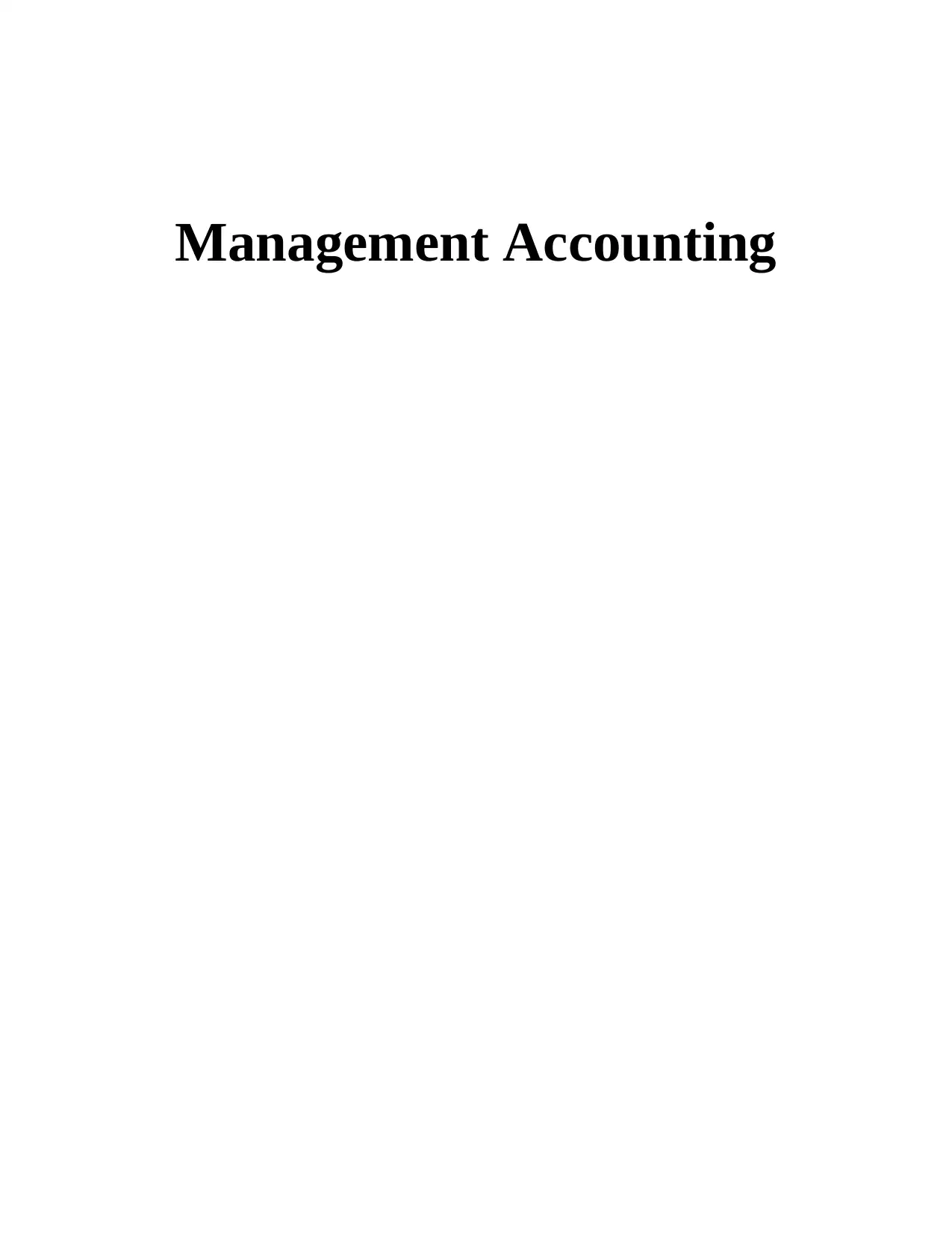
Management Accounting
Paraphrase This Document
Need a fresh take? Get an instant paraphrase of this document with our AI Paraphraser
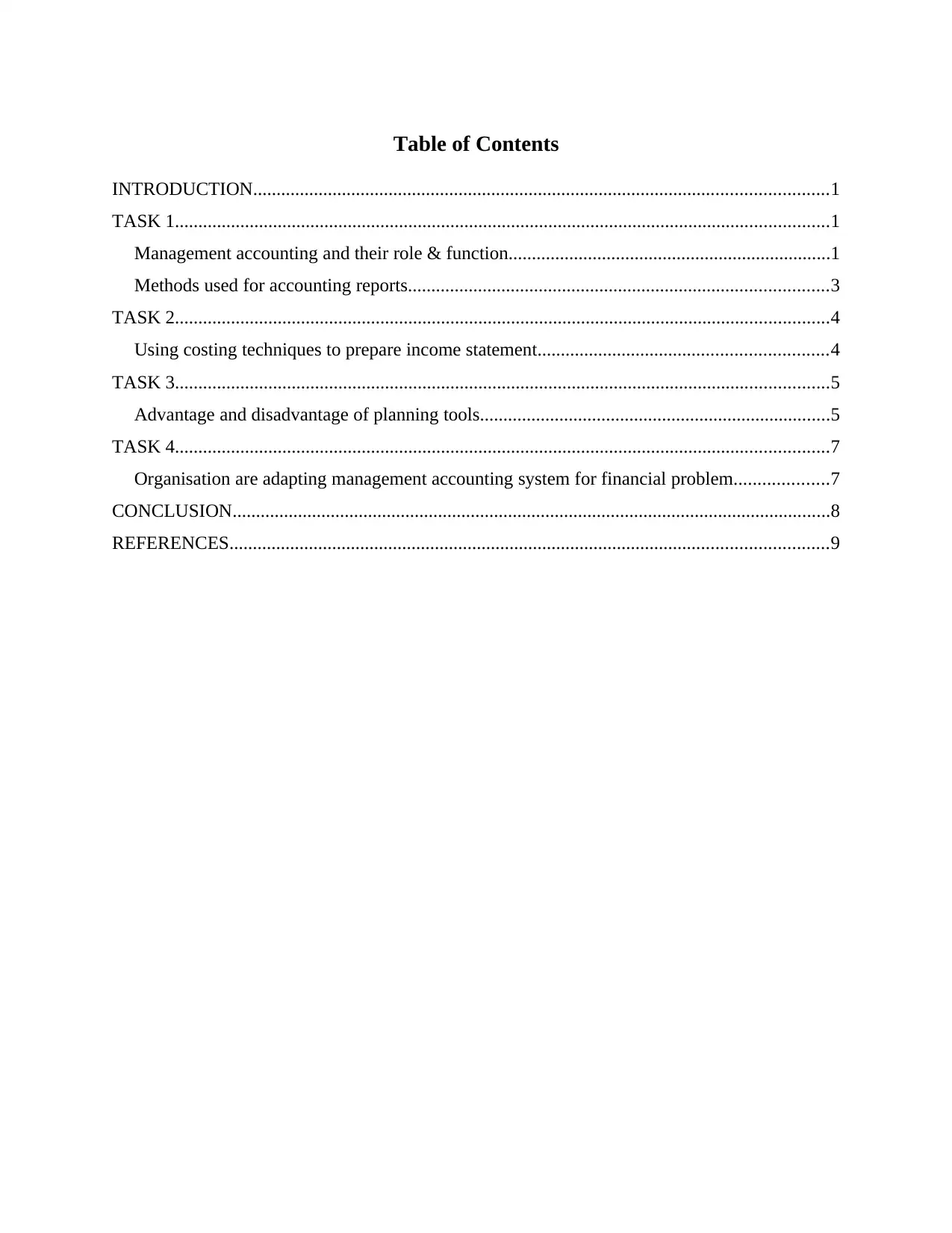
Table of Contents
INTRODUCTION...........................................................................................................................1
TASK 1............................................................................................................................................1
Management accounting and their role & function.....................................................................1
Methods used for accounting reports..........................................................................................3
TASK 2............................................................................................................................................4
Using costing techniques to prepare income statement..............................................................4
TASK 3............................................................................................................................................5
Advantage and disadvantage of planning tools...........................................................................5
TASK 4............................................................................................................................................7
Organisation are adapting management accounting system for financial problem....................7
CONCLUSION................................................................................................................................8
REFERENCES................................................................................................................................9
INTRODUCTION...........................................................................................................................1
TASK 1............................................................................................................................................1
Management accounting and their role & function.....................................................................1
Methods used for accounting reports..........................................................................................3
TASK 2............................................................................................................................................4
Using costing techniques to prepare income statement..............................................................4
TASK 3............................................................................................................................................5
Advantage and disadvantage of planning tools...........................................................................5
TASK 4............................................................................................................................................7
Organisation are adapting management accounting system for financial problem....................7
CONCLUSION................................................................................................................................8
REFERENCES................................................................................................................................9
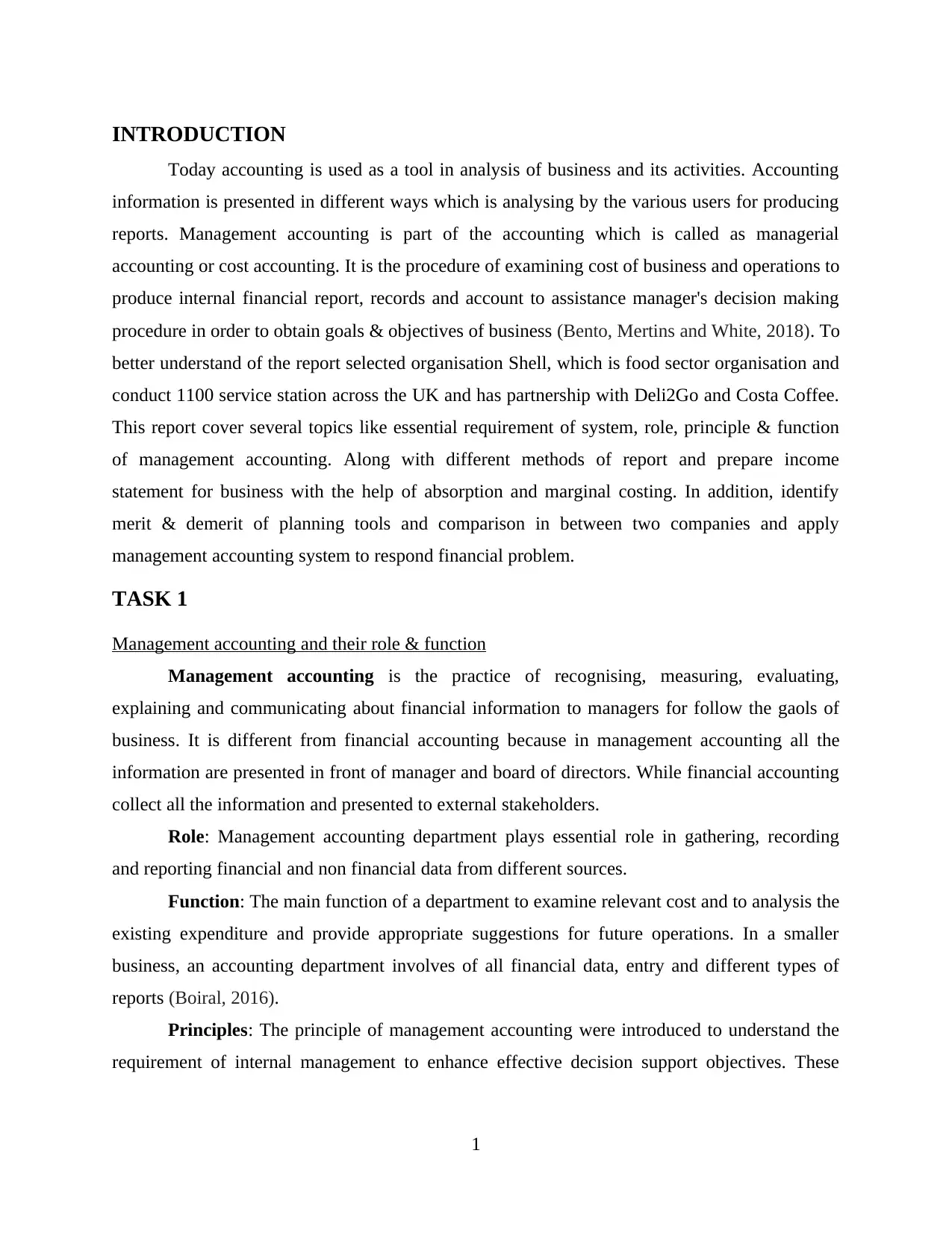
INTRODUCTION
Today accounting is used as a tool in analysis of business and its activities. Accounting
information is presented in different ways which is analysing by the various users for producing
reports. Management accounting is part of the accounting which is called as managerial
accounting or cost accounting. It is the procedure of examining cost of business and operations to
produce internal financial report, records and account to assistance manager's decision making
procedure in order to obtain goals & objectives of business (Bento, Mertins and White, 2018). To
better understand of the report selected organisation Shell, which is food sector organisation and
conduct 1100 service station across the UK and has partnership with Deli2Go and Costa Coffee.
This report cover several topics like essential requirement of system, role, principle & function
of management accounting. Along with different methods of report and prepare income
statement for business with the help of absorption and marginal costing. In addition, identify
merit & demerit of planning tools and comparison in between two companies and apply
management accounting system to respond financial problem.
TASK 1
Management accounting and their role & function
Management accounting is the practice of recognising, measuring, evaluating,
explaining and communicating about financial information to managers for follow the gaols of
business. It is different from financial accounting because in management accounting all the
information are presented in front of manager and board of directors. While financial accounting
collect all the information and presented to external stakeholders.
Role: Management accounting department plays essential role in gathering, recording
and reporting financial and non financial data from different sources.
Function: The main function of a department to examine relevant cost and to analysis the
existing expenditure and provide appropriate suggestions for future operations. In a smaller
business, an accounting department involves of all financial data, entry and different types of
reports (Boiral, 2016).
Principles: The principle of management accounting were introduced to understand the
requirement of internal management to enhance effective decision support objectives. These
1
Today accounting is used as a tool in analysis of business and its activities. Accounting
information is presented in different ways which is analysing by the various users for producing
reports. Management accounting is part of the accounting which is called as managerial
accounting or cost accounting. It is the procedure of examining cost of business and operations to
produce internal financial report, records and account to assistance manager's decision making
procedure in order to obtain goals & objectives of business (Bento, Mertins and White, 2018). To
better understand of the report selected organisation Shell, which is food sector organisation and
conduct 1100 service station across the UK and has partnership with Deli2Go and Costa Coffee.
This report cover several topics like essential requirement of system, role, principle & function
of management accounting. Along with different methods of report and prepare income
statement for business with the help of absorption and marginal costing. In addition, identify
merit & demerit of planning tools and comparison in between two companies and apply
management accounting system to respond financial problem.
TASK 1
Management accounting and their role & function
Management accounting is the practice of recognising, measuring, evaluating,
explaining and communicating about financial information to managers for follow the gaols of
business. It is different from financial accounting because in management accounting all the
information are presented in front of manager and board of directors. While financial accounting
collect all the information and presented to external stakeholders.
Role: Management accounting department plays essential role in gathering, recording
and reporting financial and non financial data from different sources.
Function: The main function of a department to examine relevant cost and to analysis the
existing expenditure and provide appropriate suggestions for future operations. In a smaller
business, an accounting department involves of all financial data, entry and different types of
reports (Boiral, 2016).
Principles: The principle of management accounting were introduced to understand the
requirement of internal management to enhance effective decision support objectives. These
1
⊘ This is a preview!⊘
Do you want full access?
Subscribe today to unlock all pages.

Trusted by 1+ million students worldwide
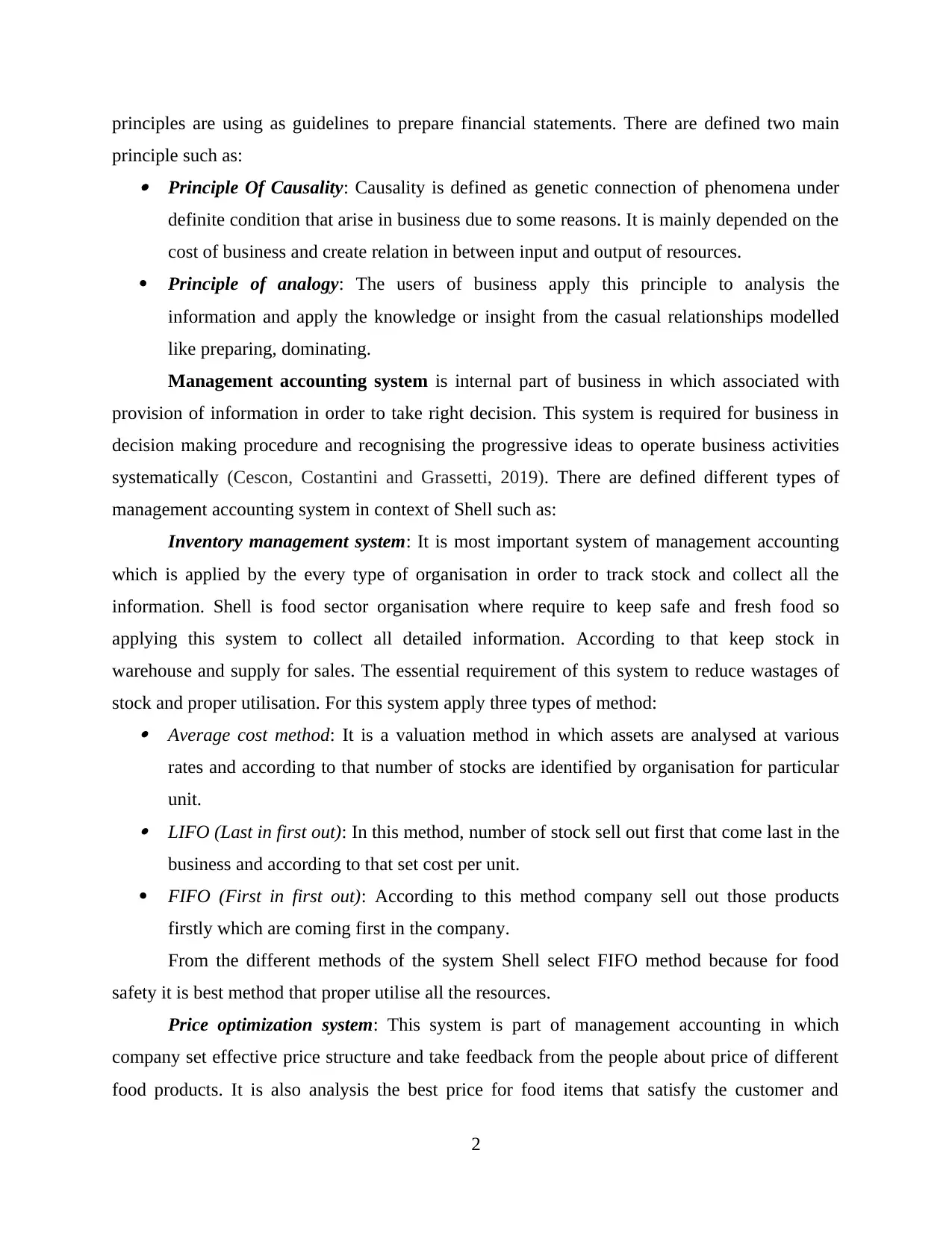
principles are using as guidelines to prepare financial statements. There are defined two main
principle such as: Principle Of Causality: Causality is defined as genetic connection of phenomena under
definite condition that arise in business due to some reasons. It is mainly depended on the
cost of business and create relation in between input and output of resources.
Principle of analogy: The users of business apply this principle to analysis the
information and apply the knowledge or insight from the casual relationships modelled
like preparing, dominating.
Management accounting system is internal part of business in which associated with
provision of information in order to take right decision. This system is required for business in
decision making procedure and recognising the progressive ideas to operate business activities
systematically (Cescon, Costantini and Grassetti, 2019). There are defined different types of
management accounting system in context of Shell such as:
Inventory management system: It is most important system of management accounting
which is applied by the every type of organisation in order to track stock and collect all the
information. Shell is food sector organisation where require to keep safe and fresh food so
applying this system to collect all detailed information. According to that keep stock in
warehouse and supply for sales. The essential requirement of this system to reduce wastages of
stock and proper utilisation. For this system apply three types of method: Average cost method: It is a valuation method in which assets are analysed at various
rates and according to that number of stocks are identified by organisation for particular
unit. LIFO (Last in first out): In this method, number of stock sell out first that come last in the
business and according to that set cost per unit.
FIFO (First in first out): According to this method company sell out those products
firstly which are coming first in the company.
From the different methods of the system Shell select FIFO method because for food
safety it is best method that proper utilise all the resources.
Price optimization system: This system is part of management accounting in which
company set effective price structure and take feedback from the people about price of different
food products. It is also analysis the best price for food items that satisfy the customer and
2
principle such as: Principle Of Causality: Causality is defined as genetic connection of phenomena under
definite condition that arise in business due to some reasons. It is mainly depended on the
cost of business and create relation in between input and output of resources.
Principle of analogy: The users of business apply this principle to analysis the
information and apply the knowledge or insight from the casual relationships modelled
like preparing, dominating.
Management accounting system is internal part of business in which associated with
provision of information in order to take right decision. This system is required for business in
decision making procedure and recognising the progressive ideas to operate business activities
systematically (Cescon, Costantini and Grassetti, 2019). There are defined different types of
management accounting system in context of Shell such as:
Inventory management system: It is most important system of management accounting
which is applied by the every type of organisation in order to track stock and collect all the
information. Shell is food sector organisation where require to keep safe and fresh food so
applying this system to collect all detailed information. According to that keep stock in
warehouse and supply for sales. The essential requirement of this system to reduce wastages of
stock and proper utilisation. For this system apply three types of method: Average cost method: It is a valuation method in which assets are analysed at various
rates and according to that number of stocks are identified by organisation for particular
unit. LIFO (Last in first out): In this method, number of stock sell out first that come last in the
business and according to that set cost per unit.
FIFO (First in first out): According to this method company sell out those products
firstly which are coming first in the company.
From the different methods of the system Shell select FIFO method because for food
safety it is best method that proper utilise all the resources.
Price optimization system: This system is part of management accounting in which
company set effective price structure and take feedback from the people about price of different
food products. It is also analysis the best price for food items that satisfy the customer and
2
Paraphrase This Document
Need a fresh take? Get an instant paraphrase of this document with our AI Paraphraser
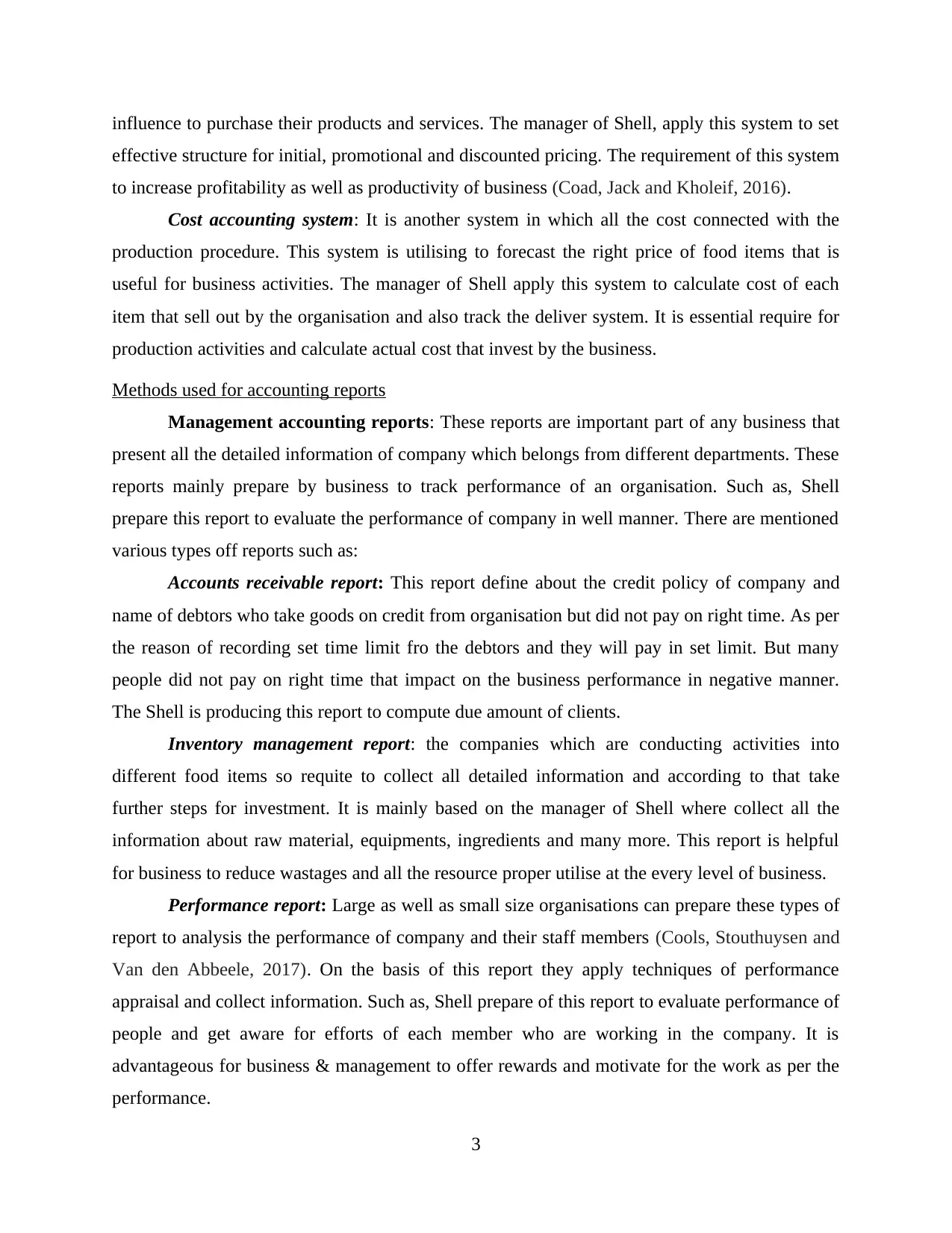
influence to purchase their products and services. The manager of Shell, apply this system to set
effective structure for initial, promotional and discounted pricing. The requirement of this system
to increase profitability as well as productivity of business (Coad, Jack and Kholeif, 2016).
Cost accounting system: It is another system in which all the cost connected with the
production procedure. This system is utilising to forecast the right price of food items that is
useful for business activities. The manager of Shell apply this system to calculate cost of each
item that sell out by the organisation and also track the deliver system. It is essential require for
production activities and calculate actual cost that invest by the business.
Methods used for accounting reports
Management accounting reports: These reports are important part of any business that
present all the detailed information of company which belongs from different departments. These
reports mainly prepare by business to track performance of an organisation. Such as, Shell
prepare this report to evaluate the performance of company in well manner. There are mentioned
various types off reports such as:
Accounts receivable report: This report define about the credit policy of company and
name of debtors who take goods on credit from organisation but did not pay on right time. As per
the reason of recording set time limit fro the debtors and they will pay in set limit. But many
people did not pay on right time that impact on the business performance in negative manner.
The Shell is producing this report to compute due amount of clients.
Inventory management report: the companies which are conducting activities into
different food items so requite to collect all detailed information and according to that take
further steps for investment. It is mainly based on the manager of Shell where collect all the
information about raw material, equipments, ingredients and many more. This report is helpful
for business to reduce wastages and all the resource proper utilise at the every level of business.
Performance report: Large as well as small size organisations can prepare these types of
report to analysis the performance of company and their staff members (Cools, Stouthuysen and
Van den Abbeele, 2017). On the basis of this report they apply techniques of performance
appraisal and collect information. Such as, Shell prepare of this report to evaluate performance of
people and get aware for efforts of each member who are working in the company. It is
advantageous for business & management to offer rewards and motivate for the work as per the
performance.
3
effective structure for initial, promotional and discounted pricing. The requirement of this system
to increase profitability as well as productivity of business (Coad, Jack and Kholeif, 2016).
Cost accounting system: It is another system in which all the cost connected with the
production procedure. This system is utilising to forecast the right price of food items that is
useful for business activities. The manager of Shell apply this system to calculate cost of each
item that sell out by the organisation and also track the deliver system. It is essential require for
production activities and calculate actual cost that invest by the business.
Methods used for accounting reports
Management accounting reports: These reports are important part of any business that
present all the detailed information of company which belongs from different departments. These
reports mainly prepare by business to track performance of an organisation. Such as, Shell
prepare this report to evaluate the performance of company in well manner. There are mentioned
various types off reports such as:
Accounts receivable report: This report define about the credit policy of company and
name of debtors who take goods on credit from organisation but did not pay on right time. As per
the reason of recording set time limit fro the debtors and they will pay in set limit. But many
people did not pay on right time that impact on the business performance in negative manner.
The Shell is producing this report to compute due amount of clients.
Inventory management report: the companies which are conducting activities into
different food items so requite to collect all detailed information and according to that take
further steps for investment. It is mainly based on the manager of Shell where collect all the
information about raw material, equipments, ingredients and many more. This report is helpful
for business to reduce wastages and all the resource proper utilise at the every level of business.
Performance report: Large as well as small size organisations can prepare these types of
report to analysis the performance of company and their staff members (Cools, Stouthuysen and
Van den Abbeele, 2017). On the basis of this report they apply techniques of performance
appraisal and collect information. Such as, Shell prepare of this report to evaluate performance of
people and get aware for efforts of each member who are working in the company. It is
advantageous for business & management to offer rewards and motivate for the work as per the
performance.
3
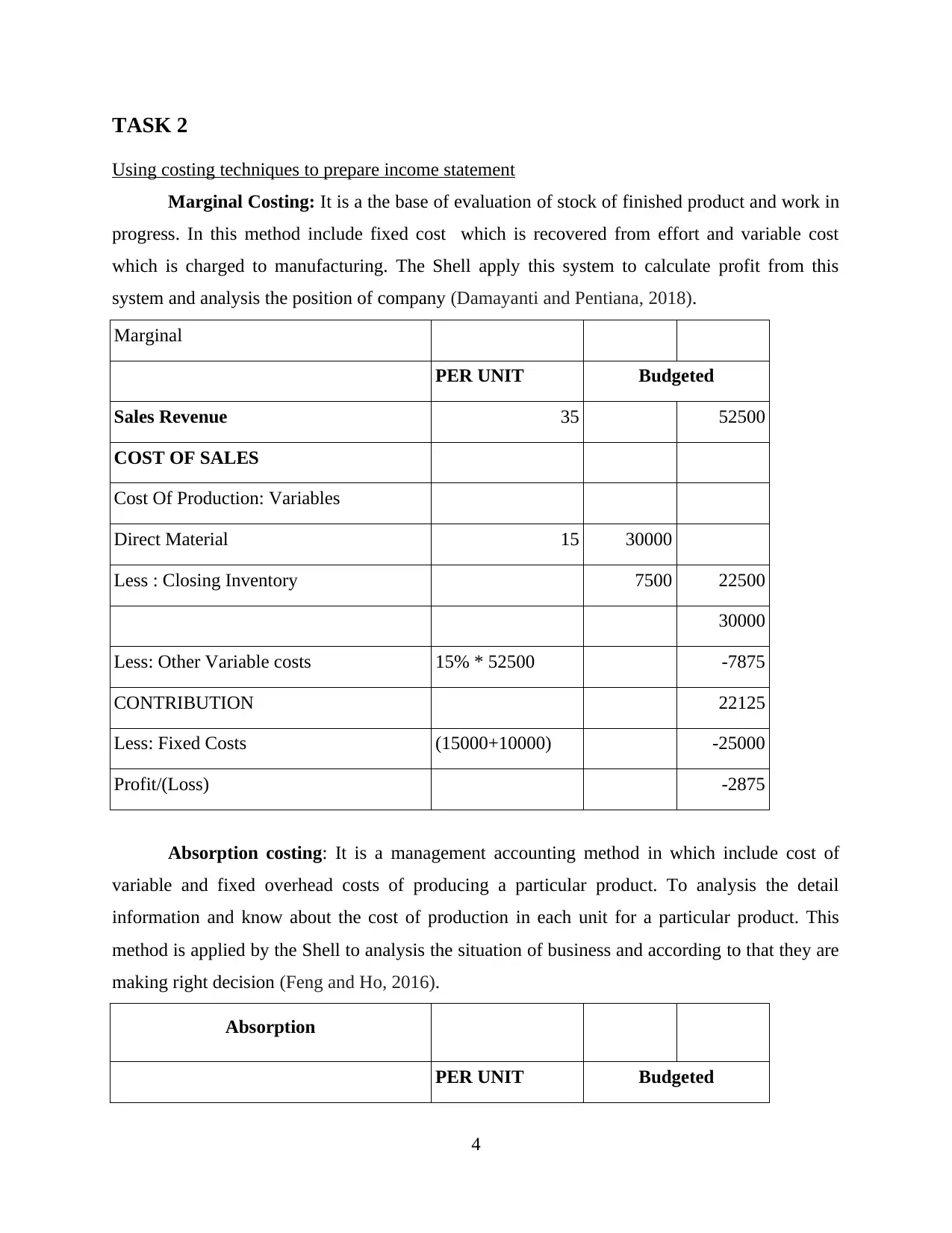
TASK 2
Using costing techniques to prepare income statement
Marginal Costing: It is a the base of evaluation of stock of finished product and work in
progress. In this method include fixed cost which is recovered from effort and variable cost
which is charged to manufacturing. The Shell apply this system to calculate profit from this
system and analysis the position of company (Damayanti and Pentiana, 2018).
Marginal
PER UNIT Budgeted
Sales Revenue 35 52500
COST OF SALES
Cost Of Production: Variables
Direct Material 15 30000
Less : Closing Inventory 7500 22500
30000
Less: Other Variable costs 15% * 52500 -7875
CONTRIBUTION 22125
Less: Fixed Costs (15000+10000) -25000
Profit/(Loss) -2875
Absorption costing: It is a management accounting method in which include cost of
variable and fixed overhead costs of producing a particular product. To analysis the detail
information and know about the cost of production in each unit for a particular product. This
method is applied by the Shell to analysis the situation of business and according to that they are
making right decision (Feng and Ho, 2016).
Absorption
PER UNIT Budgeted
4
Using costing techniques to prepare income statement
Marginal Costing: It is a the base of evaluation of stock of finished product and work in
progress. In this method include fixed cost which is recovered from effort and variable cost
which is charged to manufacturing. The Shell apply this system to calculate profit from this
system and analysis the position of company (Damayanti and Pentiana, 2018).
Marginal
PER UNIT Budgeted
Sales Revenue 35 52500
COST OF SALES
Cost Of Production: Variables
Direct Material 15 30000
Less : Closing Inventory 7500 22500
30000
Less: Other Variable costs 15% * 52500 -7875
CONTRIBUTION 22125
Less: Fixed Costs (15000+10000) -25000
Profit/(Loss) -2875
Absorption costing: It is a management accounting method in which include cost of
variable and fixed overhead costs of producing a particular product. To analysis the detail
information and know about the cost of production in each unit for a particular product. This
method is applied by the Shell to analysis the situation of business and according to that they are
making right decision (Feng and Ho, 2016).
Absorption
PER UNIT Budgeted
4
⊘ This is a preview!⊘
Do you want full access?
Subscribe today to unlock all pages.

Trusted by 1+ million students worldwide
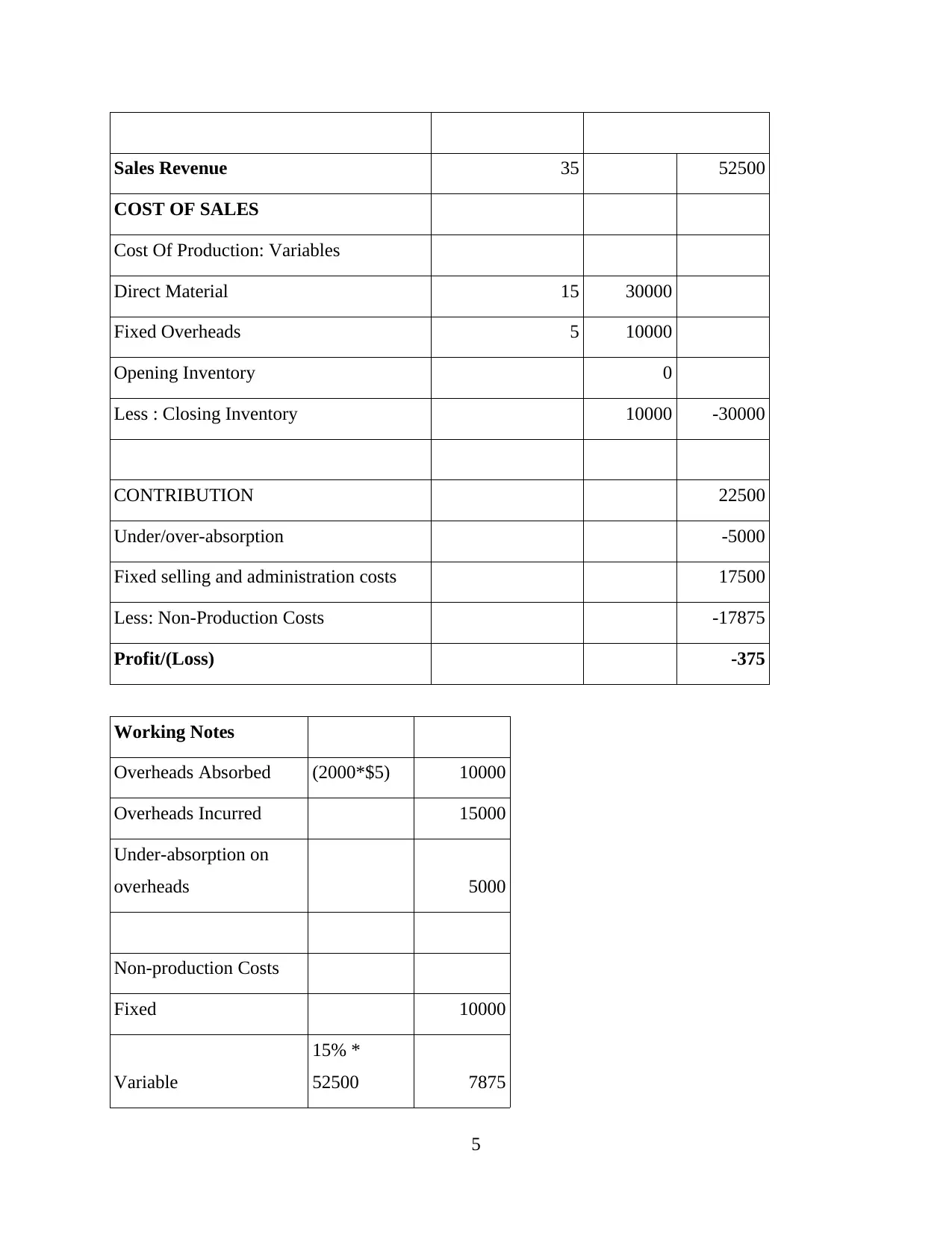
Sales Revenue 35 52500
COST OF SALES
Cost Of Production: Variables
Direct Material 15 30000
Fixed Overheads 5 10000
Opening Inventory 0
Less : Closing Inventory 10000 -30000
CONTRIBUTION 22500
Under/over-absorption -5000
Fixed selling and administration costs 17500
Less: Non-Production Costs -17875
Profit/(Loss) -375
Working Notes
Overheads Absorbed (2000*$5) 10000
Overheads Incurred 15000
Under-absorption on
overheads 5000
Non-production Costs
Fixed 10000
Variable
15% *
52500 7875
5
COST OF SALES
Cost Of Production: Variables
Direct Material 15 30000
Fixed Overheads 5 10000
Opening Inventory 0
Less : Closing Inventory 10000 -30000
CONTRIBUTION 22500
Under/over-absorption -5000
Fixed selling and administration costs 17500
Less: Non-Production Costs -17875
Profit/(Loss) -375
Working Notes
Overheads Absorbed (2000*$5) 10000
Overheads Incurred 15000
Under-absorption on
overheads 5000
Non-production Costs
Fixed 10000
Variable
15% *
52500 7875
5
Paraphrase This Document
Need a fresh take? Get an instant paraphrase of this document with our AI Paraphraser
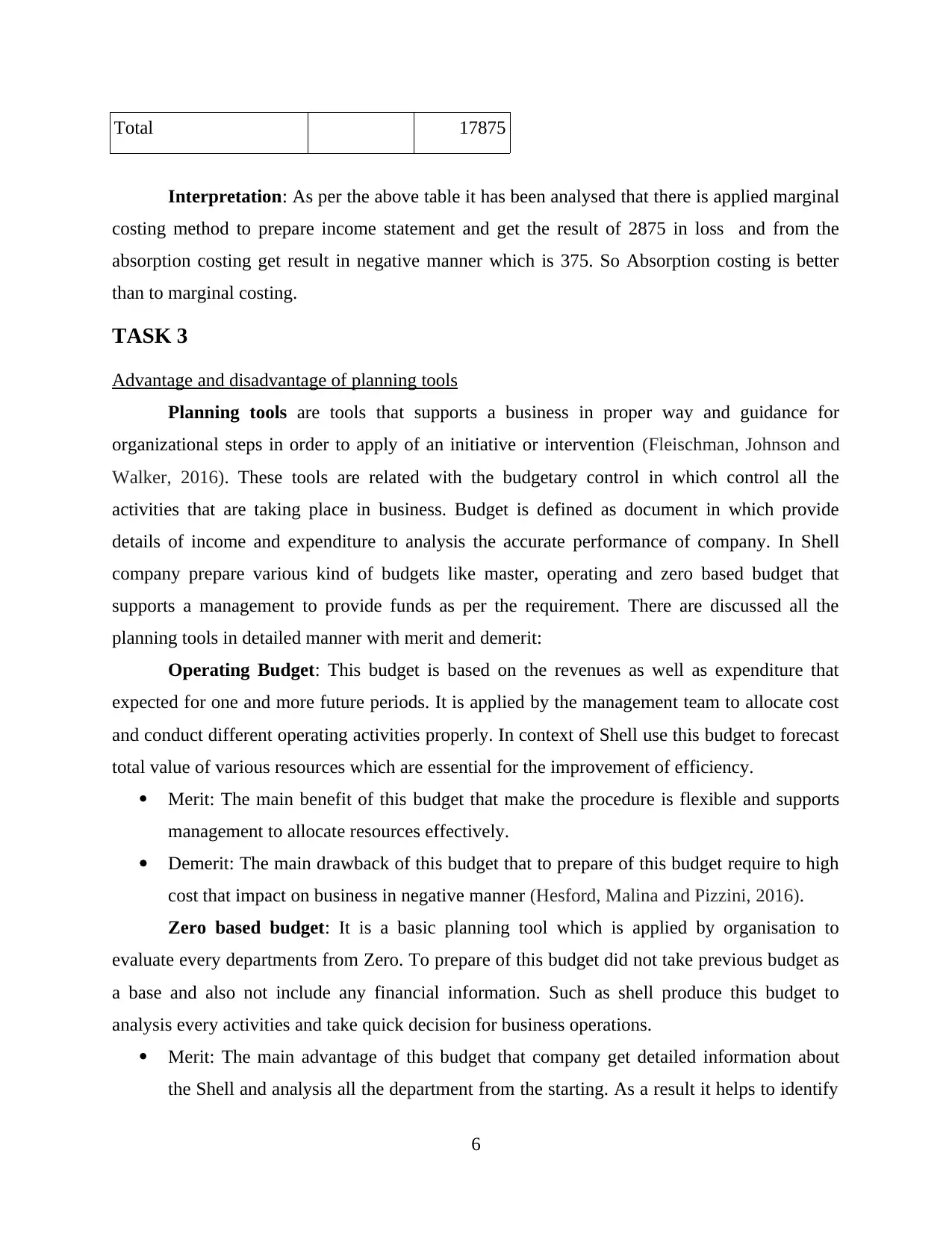
Total 17875
Interpretation: As per the above table it has been analysed that there is applied marginal
costing method to prepare income statement and get the result of 2875 in loss and from the
absorption costing get result in negative manner which is 375. So Absorption costing is better
than to marginal costing.
TASK 3
Advantage and disadvantage of planning tools
Planning tools are tools that supports a business in proper way and guidance for
organizational steps in order to apply of an initiative or intervention (Fleischman, Johnson and
Walker, 2016). These tools are related with the budgetary control in which control all the
activities that are taking place in business. Budget is defined as document in which provide
details of income and expenditure to analysis the accurate performance of company. In Shell
company prepare various kind of budgets like master, operating and zero based budget that
supports a management to provide funds as per the requirement. There are discussed all the
planning tools in detailed manner with merit and demerit:
Operating Budget: This budget is based on the revenues as well as expenditure that
expected for one and more future periods. It is applied by the management team to allocate cost
and conduct different operating activities properly. In context of Shell use this budget to forecast
total value of various resources which are essential for the improvement of efficiency.
Merit: The main benefit of this budget that make the procedure is flexible and supports
management to allocate resources effectively.
Demerit: The main drawback of this budget that to prepare of this budget require to high
cost that impact on business in negative manner (Hesford, Malina and Pizzini, 2016).
Zero based budget: It is a basic planning tool which is applied by organisation to
evaluate every departments from Zero. To prepare of this budget did not take previous budget as
a base and also not include any financial information. Such as shell produce this budget to
analysis every activities and take quick decision for business operations.
Merit: The main advantage of this budget that company get detailed information about
the Shell and analysis all the department from the starting. As a result it helps to identify
6
Interpretation: As per the above table it has been analysed that there is applied marginal
costing method to prepare income statement and get the result of 2875 in loss and from the
absorption costing get result in negative manner which is 375. So Absorption costing is better
than to marginal costing.
TASK 3
Advantage and disadvantage of planning tools
Planning tools are tools that supports a business in proper way and guidance for
organizational steps in order to apply of an initiative or intervention (Fleischman, Johnson and
Walker, 2016). These tools are related with the budgetary control in which control all the
activities that are taking place in business. Budget is defined as document in which provide
details of income and expenditure to analysis the accurate performance of company. In Shell
company prepare various kind of budgets like master, operating and zero based budget that
supports a management to provide funds as per the requirement. There are discussed all the
planning tools in detailed manner with merit and demerit:
Operating Budget: This budget is based on the revenues as well as expenditure that
expected for one and more future periods. It is applied by the management team to allocate cost
and conduct different operating activities properly. In context of Shell use this budget to forecast
total value of various resources which are essential for the improvement of efficiency.
Merit: The main benefit of this budget that make the procedure is flexible and supports
management to allocate resources effectively.
Demerit: The main drawback of this budget that to prepare of this budget require to high
cost that impact on business in negative manner (Hesford, Malina and Pizzini, 2016).
Zero based budget: It is a basic planning tool which is applied by organisation to
evaluate every departments from Zero. To prepare of this budget did not take previous budget as
a base and also not include any financial information. Such as shell produce this budget to
analysis every activities and take quick decision for business operations.
Merit: The main advantage of this budget that company get detailed information about
the Shell and analysis all the department from the starting. As a result it helps to identify
6
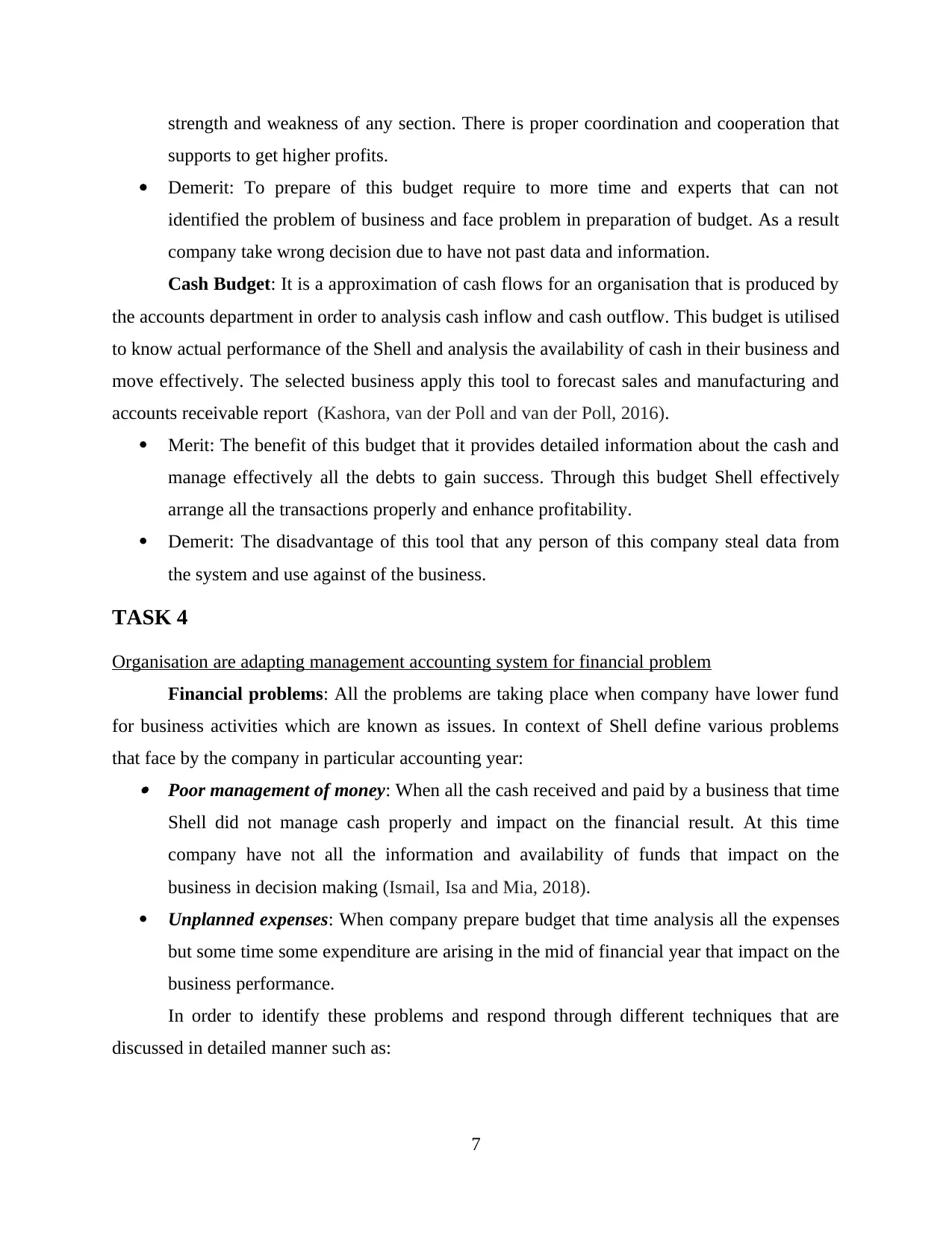
strength and weakness of any section. There is proper coordination and cooperation that
supports to get higher profits.
Demerit: To prepare of this budget require to more time and experts that can not
identified the problem of business and face problem in preparation of budget. As a result
company take wrong decision due to have not past data and information.
Cash Budget: It is a approximation of cash flows for an organisation that is produced by
the accounts department in order to analysis cash inflow and cash outflow. This budget is utilised
to know actual performance of the Shell and analysis the availability of cash in their business and
move effectively. The selected business apply this tool to forecast sales and manufacturing and
accounts receivable report (Kashora, van der Poll and van der Poll, 2016).
Merit: The benefit of this budget that it provides detailed information about the cash and
manage effectively all the debts to gain success. Through this budget Shell effectively
arrange all the transactions properly and enhance profitability.
Demerit: The disadvantage of this tool that any person of this company steal data from
the system and use against of the business.
TASK 4
Organisation are adapting management accounting system for financial problem
Financial problems: All the problems are taking place when company have lower fund
for business activities which are known as issues. In context of Shell define various problems
that face by the company in particular accounting year: Poor management of money: When all the cash received and paid by a business that time
Shell did not manage cash properly and impact on the financial result. At this time
company have not all the information and availability of funds that impact on the
business in decision making (Ismail, Isa and Mia, 2018).
Unplanned expenses: When company prepare budget that time analysis all the expenses
but some time some expenditure are arising in the mid of financial year that impact on the
business performance.
In order to identify these problems and respond through different techniques that are
discussed in detailed manner such as:
7
supports to get higher profits.
Demerit: To prepare of this budget require to more time and experts that can not
identified the problem of business and face problem in preparation of budget. As a result
company take wrong decision due to have not past data and information.
Cash Budget: It is a approximation of cash flows for an organisation that is produced by
the accounts department in order to analysis cash inflow and cash outflow. This budget is utilised
to know actual performance of the Shell and analysis the availability of cash in their business and
move effectively. The selected business apply this tool to forecast sales and manufacturing and
accounts receivable report (Kashora, van der Poll and van der Poll, 2016).
Merit: The benefit of this budget that it provides detailed information about the cash and
manage effectively all the debts to gain success. Through this budget Shell effectively
arrange all the transactions properly and enhance profitability.
Demerit: The disadvantage of this tool that any person of this company steal data from
the system and use against of the business.
TASK 4
Organisation are adapting management accounting system for financial problem
Financial problems: All the problems are taking place when company have lower fund
for business activities which are known as issues. In context of Shell define various problems
that face by the company in particular accounting year: Poor management of money: When all the cash received and paid by a business that time
Shell did not manage cash properly and impact on the financial result. At this time
company have not all the information and availability of funds that impact on the
business in decision making (Ismail, Isa and Mia, 2018).
Unplanned expenses: When company prepare budget that time analysis all the expenses
but some time some expenditure are arising in the mid of financial year that impact on the
business performance.
In order to identify these problems and respond through different techniques that are
discussed in detailed manner such as:
7
⊘ This is a preview!⊘
Do you want full access?
Subscribe today to unlock all pages.

Trusted by 1+ million students worldwide
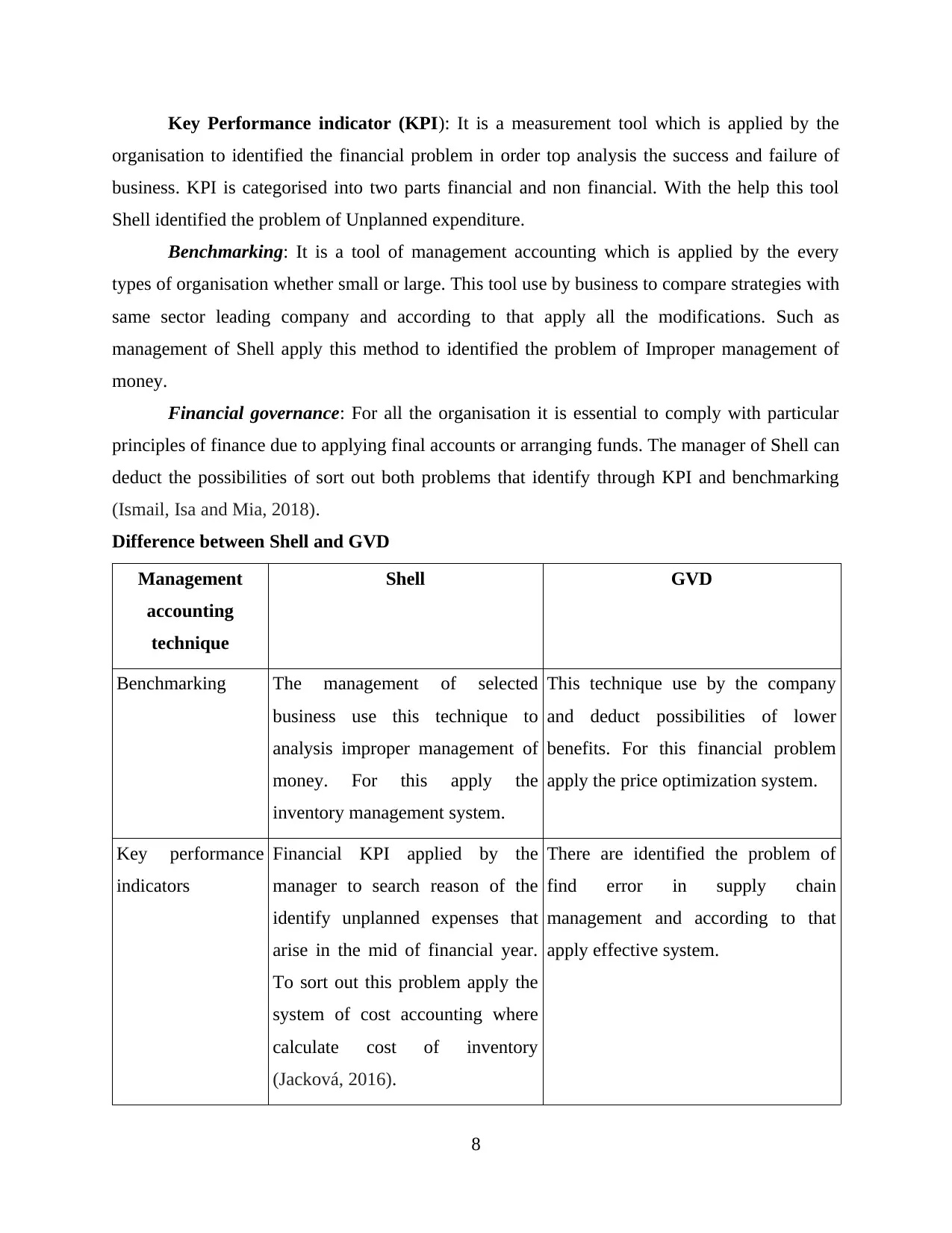
Key Performance indicator (KPI): It is a measurement tool which is applied by the
organisation to identified the financial problem in order top analysis the success and failure of
business. KPI is categorised into two parts financial and non financial. With the help this tool
Shell identified the problem of Unplanned expenditure.
Benchmarking: It is a tool of management accounting which is applied by the every
types of organisation whether small or large. This tool use by business to compare strategies with
same sector leading company and according to that apply all the modifications. Such as
management of Shell apply this method to identified the problem of Improper management of
money.
Financial governance: For all the organisation it is essential to comply with particular
principles of finance due to applying final accounts or arranging funds. The manager of Shell can
deduct the possibilities of sort out both problems that identify through KPI and benchmarking
(Ismail, Isa and Mia, 2018).
Difference between Shell and GVD
Management
accounting
technique
Shell GVD
Benchmarking The management of selected
business use this technique to
analysis improper management of
money. For this apply the
inventory management system.
This technique use by the company
and deduct possibilities of lower
benefits. For this financial problem
apply the price optimization system.
Key performance
indicators
Financial KPI applied by the
manager to search reason of the
identify unplanned expenses that
arise in the mid of financial year.
To sort out this problem apply the
system of cost accounting where
calculate cost of inventory
(Jacková, 2016).
There are identified the problem of
find error in supply chain
management and according to that
apply effective system.
8
organisation to identified the financial problem in order top analysis the success and failure of
business. KPI is categorised into two parts financial and non financial. With the help this tool
Shell identified the problem of Unplanned expenditure.
Benchmarking: It is a tool of management accounting which is applied by the every
types of organisation whether small or large. This tool use by business to compare strategies with
same sector leading company and according to that apply all the modifications. Such as
management of Shell apply this method to identified the problem of Improper management of
money.
Financial governance: For all the organisation it is essential to comply with particular
principles of finance due to applying final accounts or arranging funds. The manager of Shell can
deduct the possibilities of sort out both problems that identify through KPI and benchmarking
(Ismail, Isa and Mia, 2018).
Difference between Shell and GVD
Management
accounting
technique
Shell GVD
Benchmarking The management of selected
business use this technique to
analysis improper management of
money. For this apply the
inventory management system.
This technique use by the company
and deduct possibilities of lower
benefits. For this financial problem
apply the price optimization system.
Key performance
indicators
Financial KPI applied by the
manager to search reason of the
identify unplanned expenses that
arise in the mid of financial year.
To sort out this problem apply the
system of cost accounting where
calculate cost of inventory
(Jacková, 2016).
There are identified the problem of
find error in supply chain
management and according to that
apply effective system.
8
Paraphrase This Document
Need a fresh take? Get an instant paraphrase of this document with our AI Paraphraser
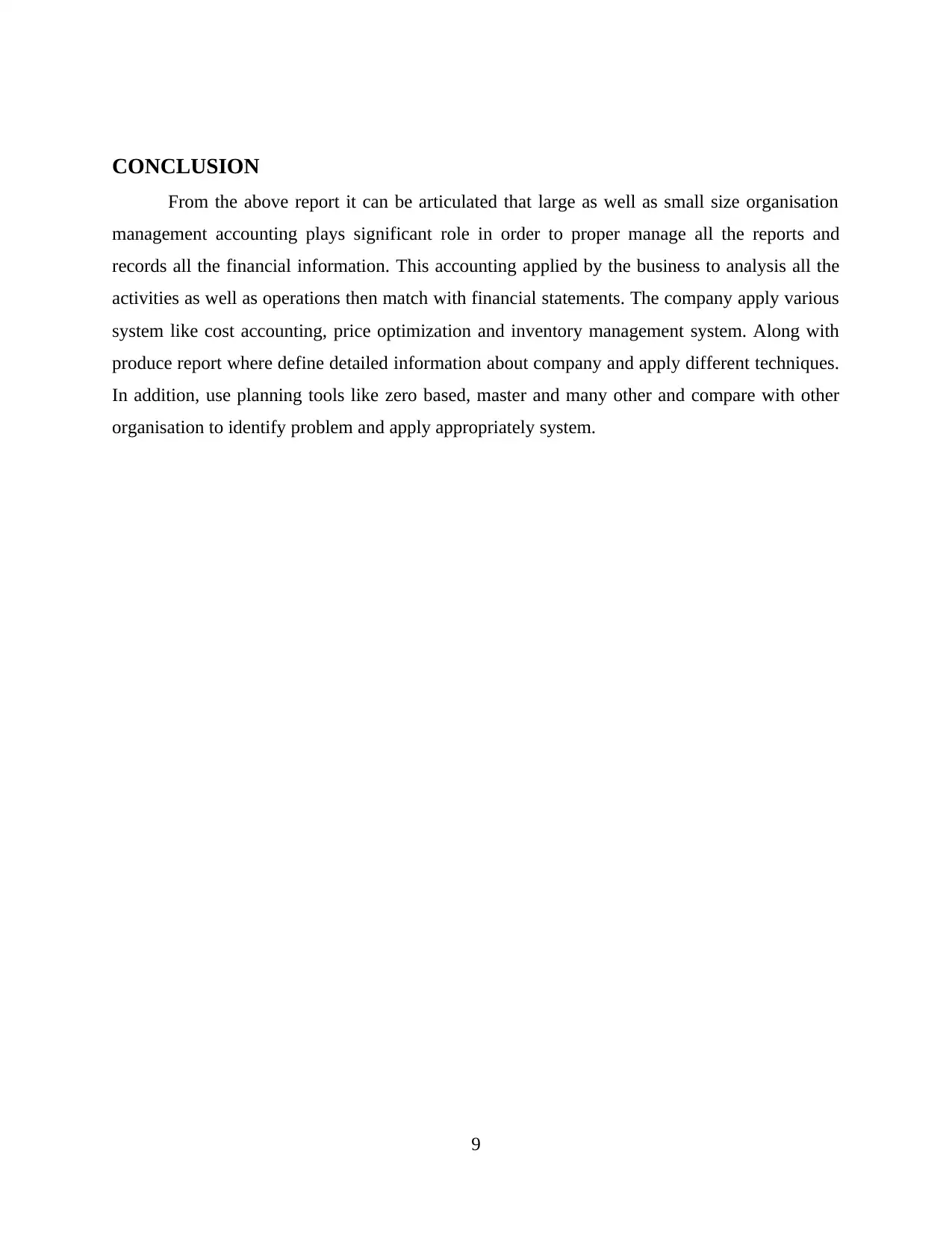
CONCLUSION
From the above report it can be articulated that large as well as small size organisation
management accounting plays significant role in order to proper manage all the reports and
records all the financial information. This accounting applied by the business to analysis all the
activities as well as operations then match with financial statements. The company apply various
system like cost accounting, price optimization and inventory management system. Along with
produce report where define detailed information about company and apply different techniques.
In addition, use planning tools like zero based, master and many other and compare with other
organisation to identify problem and apply appropriately system.
9
From the above report it can be articulated that large as well as small size organisation
management accounting plays significant role in order to proper manage all the reports and
records all the financial information. This accounting applied by the business to analysis all the
activities as well as operations then match with financial statements. The company apply various
system like cost accounting, price optimization and inventory management system. Along with
produce report where define detailed information about company and apply different techniques.
In addition, use planning tools like zero based, master and many other and compare with other
organisation to identify problem and apply appropriately system.
9
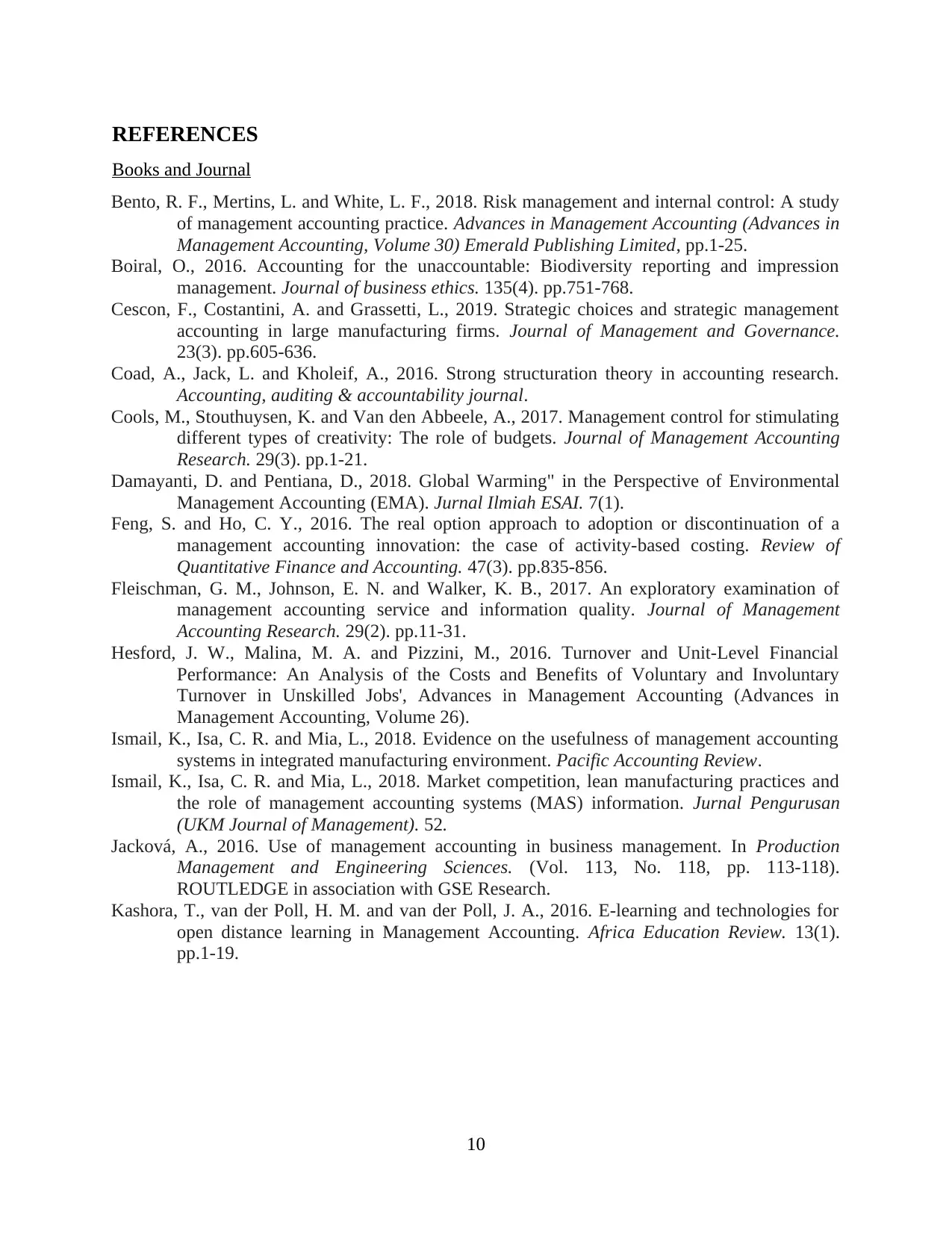
REFERENCES
Books and Journal
Bento, R. F., Mertins, L. and White, L. F., 2018. Risk management and internal control: A study
of management accounting practice. Advances in Management Accounting (Advances in
Management Accounting, Volume 30) Emerald Publishing Limited, pp.1-25.
Boiral, O., 2016. Accounting for the unaccountable: Biodiversity reporting and impression
management. Journal of business ethics. 135(4). pp.751-768.
Cescon, F., Costantini, A. and Grassetti, L., 2019. Strategic choices and strategic management
accounting in large manufacturing firms. Journal of Management and Governance.
23(3). pp.605-636.
Coad, A., Jack, L. and Kholeif, A., 2016. Strong structuration theory in accounting research.
Accounting, auditing & accountability journal.
Cools, M., Stouthuysen, K. and Van den Abbeele, A., 2017. Management control for stimulating
different types of creativity: The role of budgets. Journal of Management Accounting
Research. 29(3). pp.1-21.
Damayanti, D. and Pentiana, D., 2018. Global Warming" in the Perspective of Environmental
Management Accounting (EMA). Jurnal Ilmiah ESAI. 7(1).
Feng, S. and Ho, C. Y., 2016. The real option approach to adoption or discontinuation of a
management accounting innovation: the case of activity-based costing. Review of
Quantitative Finance and Accounting. 47(3). pp.835-856.
Fleischman, G. M., Johnson, E. N. and Walker, K. B., 2017. An exploratory examination of
management accounting service and information quality. Journal of Management
Accounting Research. 29(2). pp.11-31.
Hesford, J. W., Malina, M. A. and Pizzini, M., 2016. Turnover and Unit-Level Financial
Performance: An Analysis of the Costs and Benefits of Voluntary and Involuntary
Turnover in Unskilled Jobs', Advances in Management Accounting (Advances in
Management Accounting, Volume 26).
Ismail, K., Isa, C. R. and Mia, L., 2018. Evidence on the usefulness of management accounting
systems in integrated manufacturing environment. Pacific Accounting Review.
Ismail, K., Isa, C. R. and Mia, L., 2018. Market competition, lean manufacturing practices and
the role of management accounting systems (MAS) information. Jurnal Pengurusan
(UKM Journal of Management). 52.
Jacková, A., 2016. Use of management accounting in business management. In Production
Management and Engineering Sciences. (Vol. 113, No. 118, pp. 113-118).
ROUTLEDGE in association with GSE Research.
Kashora, T., van der Poll, H. M. and van der Poll, J. A., 2016. E-learning and technologies for
open distance learning in Management Accounting. Africa Education Review. 13(1).
pp.1-19.
10
Books and Journal
Bento, R. F., Mertins, L. and White, L. F., 2018. Risk management and internal control: A study
of management accounting practice. Advances in Management Accounting (Advances in
Management Accounting, Volume 30) Emerald Publishing Limited, pp.1-25.
Boiral, O., 2016. Accounting for the unaccountable: Biodiversity reporting and impression
management. Journal of business ethics. 135(4). pp.751-768.
Cescon, F., Costantini, A. and Grassetti, L., 2019. Strategic choices and strategic management
accounting in large manufacturing firms. Journal of Management and Governance.
23(3). pp.605-636.
Coad, A., Jack, L. and Kholeif, A., 2016. Strong structuration theory in accounting research.
Accounting, auditing & accountability journal.
Cools, M., Stouthuysen, K. and Van den Abbeele, A., 2017. Management control for stimulating
different types of creativity: The role of budgets. Journal of Management Accounting
Research. 29(3). pp.1-21.
Damayanti, D. and Pentiana, D., 2018. Global Warming" in the Perspective of Environmental
Management Accounting (EMA). Jurnal Ilmiah ESAI. 7(1).
Feng, S. and Ho, C. Y., 2016. The real option approach to adoption or discontinuation of a
management accounting innovation: the case of activity-based costing. Review of
Quantitative Finance and Accounting. 47(3). pp.835-856.
Fleischman, G. M., Johnson, E. N. and Walker, K. B., 2017. An exploratory examination of
management accounting service and information quality. Journal of Management
Accounting Research. 29(2). pp.11-31.
Hesford, J. W., Malina, M. A. and Pizzini, M., 2016. Turnover and Unit-Level Financial
Performance: An Analysis of the Costs and Benefits of Voluntary and Involuntary
Turnover in Unskilled Jobs', Advances in Management Accounting (Advances in
Management Accounting, Volume 26).
Ismail, K., Isa, C. R. and Mia, L., 2018. Evidence on the usefulness of management accounting
systems in integrated manufacturing environment. Pacific Accounting Review.
Ismail, K., Isa, C. R. and Mia, L., 2018. Market competition, lean manufacturing practices and
the role of management accounting systems (MAS) information. Jurnal Pengurusan
(UKM Journal of Management). 52.
Jacková, A., 2016. Use of management accounting in business management. In Production
Management and Engineering Sciences. (Vol. 113, No. 118, pp. 113-118).
ROUTLEDGE in association with GSE Research.
Kashora, T., van der Poll, H. M. and van der Poll, J. A., 2016. E-learning and technologies for
open distance learning in Management Accounting. Africa Education Review. 13(1).
pp.1-19.
10
⊘ This is a preview!⊘
Do you want full access?
Subscribe today to unlock all pages.

Trusted by 1+ million students worldwide
1 out of 12
Related Documents
Your All-in-One AI-Powered Toolkit for Academic Success.
+13062052269
info@desklib.com
Available 24*7 on WhatsApp / Email
![[object Object]](/_next/static/media/star-bottom.7253800d.svg)
Unlock your academic potential
Copyright © 2020–2025 A2Z Services. All Rights Reserved. Developed and managed by ZUCOL.




